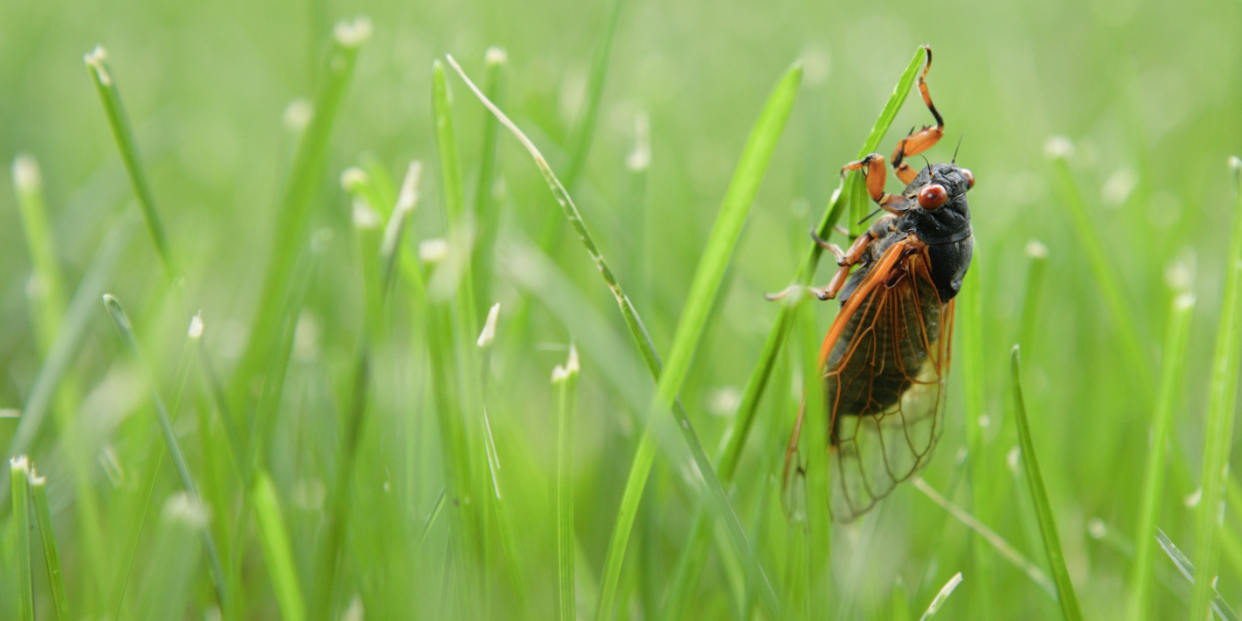Do You Need to Worry About Cicada Bites This Summer? Here’s What Experts Say

For months, people have been slightly obsessed with the coming emergence of Brood X. This massive group of cicadas is already being spotted in the eastern U.S., with many more to come as summer approaches.
Cicadas, in case you’re not familiar with them, are loud, bulbous-eyed bugs that come out of the ground after a set period of time to make lots of noise, mate, eat, and lounge just about wherever they feel like it. There are different types of cicadas and each kind comes out on a different schedule.
What makes Brood X unique is that they’re 17-year cicadas, meaning they emerge after nearly two decades underground. Brood X cicadas last surfaced in 2004—and they won’t make an appearance again until 2038, making this year’s emergence a pretty big natural phenomenon.
With all of those cicadas coming your way, it’s only natural to have some questions about what they’re like, including whether they can bite (they are a bug, after all). We asked entomologists (a.k.a. bug experts) to explain what you need to know.
First, a bit more about Brood X cicadas
There are two groups of these insects in general: annual cicadas, which come out every year, and periodical cicadas, which make their debut every 13 to 17 years.
Cicadas start out as eggs that are laid in trees by adults. Once they hatch, they fall to the ground, where they burrow into the soil. From there, they eat fluids from the tree’s roots as they grow. At some point, depending on the type of cicada they are, they come out of the ground as adult cicadas.
Brood X is actually made up of three different species: Magicicada septendecim, Magicicada cassini, and Magicicada septendecula, says Frank Meek, a board-certified entomologist and technical services manager at Rollins.
These insects are big as far as bugs go: up to two inches long. Periodical cicadas also have black bodies, orange wing veins, red eyes, and six legs.
Do cicadas bite humans or pets?
No, you will not be bitten by a cicada nor will it seek you out and attack you, says Howard Russell, M.S., a board-certified entomologist at Michigan State University.
In fact, they can’t even bite you (or your pets) if they want to. “Their mouths have no mandibles—or jaws—and they have no physical characteristics like a stinger with which to defend themselves,” says Timothy Best, a board-certified entomologist and technical manager at Terminix. What they do have, though, is a drinking straw-like appendage coming from their mouths that they use to suck up sap—but that won’t hurt you.
“Cicadas are not dangerous to people, animals, pets, or structures,” says Godfrey Nalyanya, Ph.D., associate certified entomologist at Ehrlich Pest Control, adding that they’re also not venomous and don’t pass on diseases.
To be fair, though, cicadas also have several sharp and pointy parts on their body that could make you think you’ve been bitten if you happen to handle one, Russell says.
If your pet happens to eat a cicada, Best says you shouldn’t panic. “Cicadas are not poisonous,” he says. “Dogs and cats might try to eat cicadas, but the insects alone do not pose any serious risk to them.” However, your pet might get an upset stomach, Best says, “as the exoskeleton may be difficult to digest.”
Are cicadas harmful in any other way?
Cicadas are pretty harmless as a whole, but there are some caveats. One is that their nymphs (young cicadas) like to feed on young shrubs and saplings. The females also slice into twigs to lay their eggs.
“Females may damage young broadleaf trees and shrubs when they lay eggs in the ends of small branches, which normally kills the branch above where the eggs are laid,” Russell explains. This can result in sections of dead leaves in trees, so if you recently planted new trees or shrubs, you may want to cover them before the cicadas arrive.
However, Meek says that potential harm to newly planted trees will be “mild to moderate,” pointing out that established trees will be just fine.
As for your grass, cicadas will not harm it, Nalyanya says. The only potential damage might be cicada chimneys (or holes)—small dirt structures in the ground—that these bugs create when they emerge. “When large numbers of cicada nymphs emerge from the soil, exit holes may be noticeable in a lawn,” he says. “The holes may be unsightly, but do not permanently harm the turf.”
As for the noise they create? While you’ll definitely hear it, Nalyanya says that “the sound decibels they produce are not strong enough to cause hearing damage or loss.” Instead, Meek adds, the noise will be similar to that of a “low-flying airplane or lawn mower.”
Ah, nature!
Go here to join Prevention Premium (our best value, all-access plan), subscribe to the magazine, or get digital-only access.
You Might Also Like

